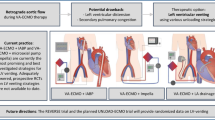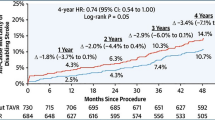Abstract
Percutaneous biventricular assist devices (BiVAD) are a recently developed treatment option for severe cardiogenic shock. This systematic review sought to identify indications and outcomes of patients placed on percutaneous BiVAD support. An electronic search was performed to identify all appropriate studies utilizing a percutaneous BiVAD configuration. Fifteen studies comprising of 20 patients were identified. Individual patient survival and outcomes data were combined for statistical analysis. All 20 patients were supported with a microaxial LVAD, 12/20 (60%) of those patients were supported with a microaxial (RMA) right ventricular assist device (RVAD), and the remaining 8/20 (40%) patients were supported with a centrifugal extracorporeal RVAD (RCF). All patients presented with cardiogenic shock, and of these, 12/20 (60%) presented with a non-ischemic etiology vs 8/20 (40%) with ischemic disease. For the RMA group, RVAD support was significantly longer [RMA 5 (IQR 4–7) days vs RCF 1 (IQR 1–2) days, p = 0.03]. Intravascular hemolysis post-BiVAD occurred in three patients (27.3%) [RMA 3 (33.3%) vs RCF 0 (0%), p = 0.94]. Five patients received a durable left ventricular assist device, one patient received a total artificial heart, and one patient underwent a heart transplantation. Estimated 30-day mortality was 15.0%, and 78.6% were discharged alive. Both strategies for percutaneous BiVAD support appear to be viable options for severe cardiogenic shock.




Similar content being viewed by others
References
Chiu C-Y, Hättasch R, Praeger D, Knebel F, Stangl K, Ramirez ID, Dreger H (2018) Percutaneous biventricular Impella support in therapy-refractory cardiogenic shock. Heart Lung 47:250–252. https://doi.org/10.1016/j.hrtlng.2018.03.009
Goda A, Takayama H, Koeckert M, Pak SW, Sutton EM, Cohen S, Uriel N, Jorde U, Mancini D, Naka Y (2011) Use of ventricular assist devices in patients with mitral valve prostheses. J Card Surg 26:334–337. https://doi.org/10.1111/j.1540-8191.2011.01248.x
Chaparro SV, Badheka A, Marzouka GR, Tanawuttiwat T, Ahmed F, Sacher V, Pham SM (2012) Combined use of Impella left ventricular assist device and extracorporeal membrane oxygenation as a bridge to recovery in fulminant myocarditis. ASAIO J 58:285–287. https://doi.org/10.1097/MAT.0b013e31824b1f70
Jumean M, Pham DT, Kapur NK (2015) Percutaneous bi-atrial extracorporeal membrane oxygenation for acute circulatory support in advanced heart failure. Catheter Cardiovasc Interv 85:1097–1099. https://doi.org/10.1002/ccd.25791
Aghili N, Bader Y, Vest AR et al (2016) Biventricular circulatory support using 2 axial flow catheters for cardiogenic shock without the need for surgical vascular access. Circ Cardiovasc Interv 9. https://doi.org/10.1161/CIRCINTERVENTIONS.116.003636
Gaudard P, Mourad M, Eliet J et al (2015) Management and outcome of patients supported with Impella 5.0 for refractory cardiogenic shock. Crit Care 19:363. https://doi.org/10.1186/s13054-015-1073-8
Hoshi H, Shinshi T, Takatani S (2006) Third-generation blood pumps with mechanical noncontact magnetic bearings. Artif Organs 30:324–338. https://doi.org/10.1111/j.1525-1594.2006.00222.x
De Robertis F, Birks EJ, Rogers P et al (2006) Clinical performance with the Levitronix Centrimag short-term ventricular assist device. J Heart Lung Transplant 25:181–186. https://doi.org/10.1016/j.healun.2005.08.019
Kar B, Adkins LE, Civitello AB et al (2006) Clinical experience with the TandemHeart percutaneous ventricular assist device. Tex Heart Inst J 33:111–115
Pappalardo F, Scandroglio AM, Latib A (2018) Full percutaneous biventricular support with two Impella pumps: the bi-Pella approach. ESC Heart Fail 5:368–371. https://doi.org/10.1002/ehf2.12274
Blum EC, Martz CR, Selektor Y, Nemeh H, Smith ZR, To L (2018) Anticoagulation of percutaneous ventricular assist device using Argatroban-based purge solution: a case series. J Pharm Pract 31:514–518. https://doi.org/10.1177/0897190017727191
Stulak JM, Lim JY, Maltais S (2014) Ventricular assist device selection: which one and when? Croat Med J 55:596–599. https://doi.org/10.3325/cmj.2014.55.596
Takayama H, Soni L, Kalesan B, Truby LK, Ota T, Cedola S, Khalpey Z, Uriel N, Colombo P, Mancini DM, Jorde UP, Naka Y (2014) Bridge-to-decision therapy with a continuous-flow external ventricular assist device in refractory cardiogenic shock of various causes. Circ Heart Fail 7:799–806. https://doi.org/10.1161/CIRCHEARTFAILURE.113.000271
Rajagopal V, Steahr G, Wilmer CI, Raval NY (2010) A novel percutaneous mechanical biventricular bridge to recovery in severe cardiac allograft rejection. J Heart Lung Transplant 29:93–95. https://doi.org/10.1016/j.healun.2009.09.015
Ellert J, Jensen MJ, Jensen LO, Møller JE (2018) Percutaneous biventricular cardiac assist device in cardiogenic shock and refractory cardiac arrest. EuroIntervention 13:e2114–e2115. https://doi.org/10.4244/eij-d-17-00637
Hunziker P, Hunziker L (2013) Percutaneous biventricular cardiac assist device in cardiogenic shock. Eur Heart J 34:1620. https://doi.org/10.1093/eurheartj/eht020
Kamioka N, Patel A, Burke MA, Greenbaum A, Babaliaros V (2019) Biventricular Impella placement via complete venous access. Catheter Cardiovasc Interv 93:E343–e345. https://doi.org/10.1002/ccd.27103
Kapur NK, Jumean M, Ghuloom A, Aghili N, Vassallo C, Kiernan MS, DeNofrio D, Pham DT (2015) First successful use of 2 axial flow catheters for percutaneous biventricular circulatory support as a bridge to a durable left ventricular assist device. Circ Heart Fail 8:1006–1008. https://doi.org/10.1161/circheartfailure.115.002374
Lasa JJ, Castellanos DA, Denfield SW (2018) First report of biventricular percutaneous Impella ventricular assist device use in pediatric patients. ASAIO J 64:e134–e137. https://doi.org/10.1097/mat.0000000000000732
Nagy CD, Jumean MF, Pham DT, Kiernan MS, Denofrio D, Kapur NK (2013) Percutaneous circulatory support for biventricular failure. Circ Cardiovasc Interv 6:e12–e14. https://doi.org/10.1161/circinterventions.112.000018
Renard BM, Hanson ID, Goldstein JA et al (2017) Severe mitral regurgitation and biventricular heart failure successfully treated with biventricular percutaneous axial flow pumps as a bridge to mitral valve surgery. Catheter Cardiovasc Interv 89:159–162. https://doi.org/10.1002/ccd.26496
Shokr M, Rashed A, Yassin AS, Kaki A, Schreiber T (2018) Use of percutaneous biventricular mechanical support in post infarction ventricular septal rupture: mechanical support for a mechanical catastrophe. J Am Coll Cardiol 71:A2186. https://doi.org/10.1016/S0735-1097(18)32727-X
Mirabel M, Luyt C-E, Leprince P, Trouillet JL, Léger P, Pavie A, Chastre J, Combes A (2011) Outcomes, long-term quality of life, and psychologic assessment of fulminant myocarditis patients rescued by mechanical circulatory support*. Crit Care Med 39:1029–1035. https://doi.org/10.1097/CCM.0b013e31820ead45
Boulate D, Luyt C-E, Pozzi M, Niculescu M, Combes A, Leprince P, Kirsch M (2013) Acute lung injury after mechanical circulatory support implantation in patients on extracorporeal life support: an unrecognized problem†. Eur J Cardiothorac Surg 44:544–550. https://doi.org/10.1093/ejcts/ezt125
Donker DW, Brodie D, Henriques JPS, Broomé M (2019) Left ventricular unloading during veno-arterial ECMO: a review of percutaneous and surgical unloading interventions. Perfusion 34:98–105. https://doi.org/10.1177/0267659118794112
Pieri M, Pappalardo F (2018) Impella RP in the treatment of right ventricular failure: what we know and where we go. J Cardiothorac Vasc Anesth 32:2339–2343. https://doi.org/10.1053/j.jvca.2018.06.007
Anderson MB, Goldstein J, Milano C, Morris LD, Kormos RL, Bhama J, Kapur NK, Bansal A, Garcia J, Baker JN, Silvestry S, Holman WL, Douglas PS, O’Neill W (2015) Benefits of a novel percutaneous ventricular assist device for right heart failure: the prospective RECOVER RIGHT study of the Impella RP device. J Heart Lung Transplant 34:1549–1560. https://doi.org/10.1016/j.healun.2015.08.018
Anderson MB, O’Brien M (2013) Use of the Impella 2.5 microaxial pump for right ventricular support after insertion of Heartmate II left ventricular assist device. Ann Thorac Surg 95:e109–e110. https://doi.org/10.1016/j.athoracsur.2012.10.013
John R, Long JW, Massey HT, Griffith BP, Sun BC, Tector AJ, Frazier OH, Joyce LD (2011) Outcomes of a multicenter trial of the Levitronix CentriMag ventricular assist system for short-term circulatory support. J Thorac Cardiovasc Surg 141:932–939. https://doi.org/10.1016/j.jtcvs.2010.03.046
Singh V, Heldman A (2015) Emergent percutaneous biventricular support during transcatheter aortic valve replacement. J Heart Valve Dis 24:313–315
Schmack B, Weymann A, Popov A-F, Patil NP, Sabashnikov A, Kremer J, Farag M, Brcic A, Lichtenstern C, Karck M, Ruhparwar A (2016) Concurrent left ventricular assist device (LVAD) implantation and percutaneous temporary RVAD support via CardiacAssist Protek-Duo TandemHeart to preempt right heart failure. Med Sci Monit Basic Res 22:53–57. https://doi.org/10.12659/MSMBR.898897
Massey HT, Choi JH, Maynes EJ, Tchantchaleishvili V (2019) Temporary support strategies for cardiogenic shock: extracorporeal membrane oxygenation, percutaneous ventricular assist devices and surgically placed extracorporeal ventricular assist devices. Ann Cardiothorac Surg 8:32–43. https://doi.org/10.21037/acs.2018.11.05
Dhruva SS, Ross JS, Mortazavi BJ, Hurley NC, Krumholz HM, Curtis JP, Berkowitz A, Masoudi FA, Messenger JC, Parzynski CS, Ngufor C, Girotra S, Amin AP, Shah ND, Desai NR (2020) Association of use of an intravascular microaxial left ventricular assist device vs intra-aortic balloon pump with in-hospital mortality and major bleeding among patients with acute myocardial infarction complicated by cardiogenic shock. Jama. 323:734. https://doi.org/10.1001/jama.2020.0254
Kuchibhotla S, Esposito ML, Breton C, Pedicini R, Mullin A, O'Kelly R, Anderson M, Morris DL, Batsides G, Ramzy D, Grise M, Pham DT, Kapur NK (2017) Acute biventricular mechanical circulatory support for cardiogenic shock. J Am Heart Assoc 6. https://doi.org/10.1161/JAHA.117.006670
Tchantchaleishvili V, Wood KL, Carlson LA, Barrus B, Swartz MF, Vidula H, Lehoux JM, Todd Massey H, Chen L (2017) Temporary mechanical circulatory support after orthotopic heart transplantation: a single-centre experience. Interact Cardiovasc Thorac Surg 25:41–46. https://doi.org/10.1093/icvts/ivx077
Phan K, Luc JGY, Xu J, Maltais S, Stulak JM, Yan TD, Tchantchaleishvili V (2017) Utilization and outcomes of temporary mechanical circulatory support for graft dysfunction after heart transplantation. ASAIO J 63:695–703. https://doi.org/10.1097/MAT.0000000000000599
Vetrovec GW, Anderson M, Schreiber T, Popma J, Lombardi W, Maini B, Moller JE, Schäfer A, Dixon SR, Hall S, Ohman EM, Mindrescu C, Moses J, O'Neill W (2018) The cVAD registry for percutaneous temporary hemodynamic support: a prospective registry of Impella mechanical circulatory support use in high-risk PCI, cardiogenic shock, and decompensated heart failure. Am Heart J 199:115–121. https://doi.org/10.1016/j.ahj.2017.09.007
Author information
Authors and Affiliations
Corresponding author
Additional information
Publisher’s note
Springer Nature remains neutral with regard to jurisdictional claims in published maps and institutional affiliations.
Electronic supplementary material
ESM 1
(DOCX 15.6 kb).
Rights and permissions
About this article
Cite this article
Weber, M.P., O’Malley, T.J., Choi, J.H. et al. Outcomes of percutaneous temporary biventricular mechanical support: a systematic review. Heart Fail Rev 27, 879–890 (2022). https://doi.org/10.1007/s10741-020-09971-7
Published:
Issue Date:
DOI: https://doi.org/10.1007/s10741-020-09971-7




